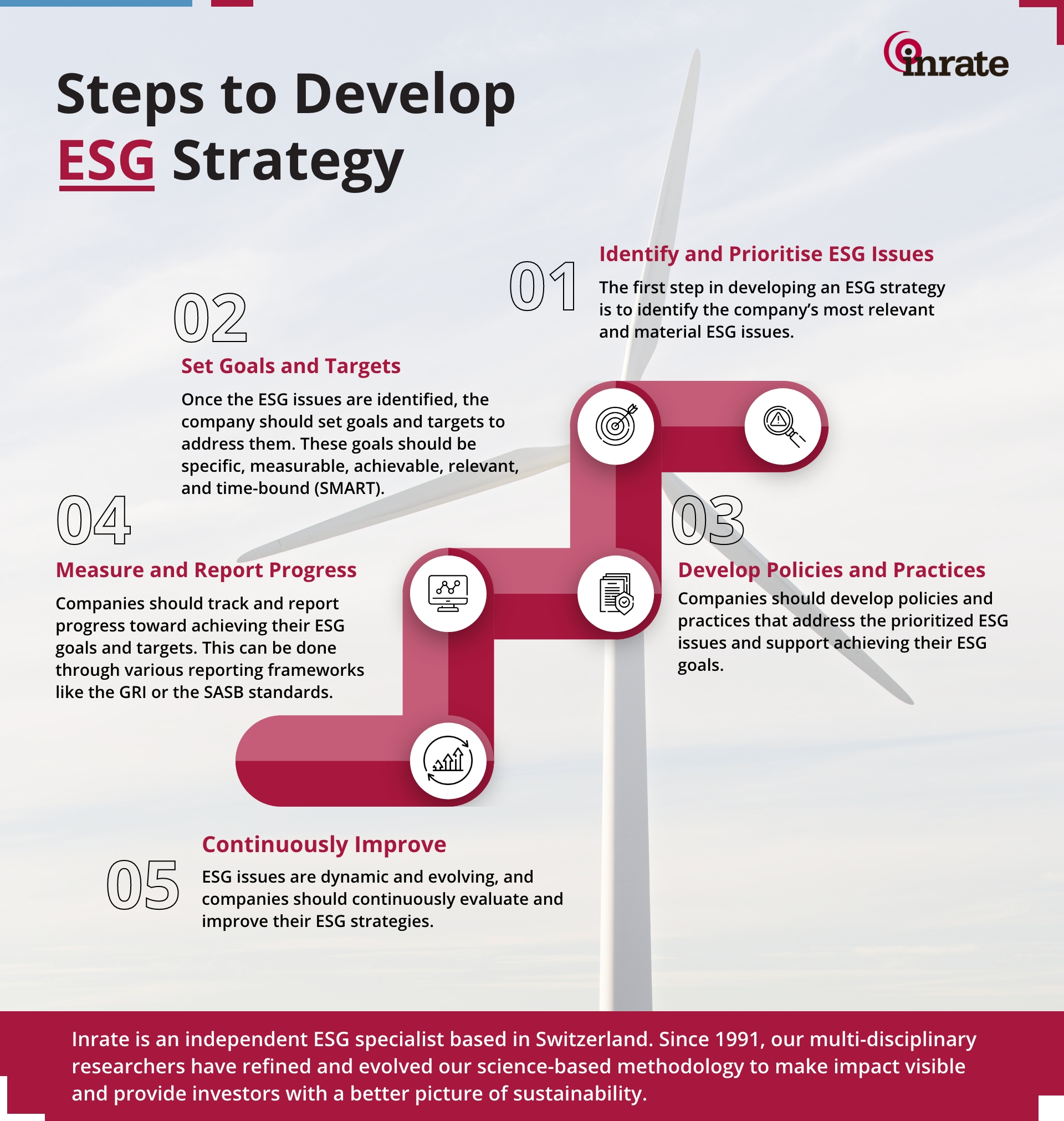Companies are under mounting pressure to consider and integrate environmental, social, and governance (ESG) concerns into their business strategies as the world becomes more aware of these challenges. ESG refers to the three critical variables used to evaluate a company’s or business’s sustainability and ethical effect.
Climate change, diversity and inclusion, human rights, labor laws, executive pay, and board diversity are all ESG concerns. An organization’s commitment to sustainability, social responsibility, and ethical governance is described in an ESG strategy. Understanding the challenges and how they affect the company is essential to creating a successful ESG strategy.
In this blog, we will go over the steps businesses may take to create a thorough ESG strategy compatible with their beliefs and objectives. We will also look at the advantages of employing this strategy, such as better stakeholder relationships, better long-term financial performance, and higher brand value.
What is ESG Strategy?
As part of its decision-making process, an Environmental, Social, Governance strategy is a corporate approach considering ESG considerations. The three key elements that assess the sustainability and ethical impact of financial investment in a business or organization are called ESG.
Environmental factors include climate change, pollution, energy usage, and biodiversity loss. Social factors include human rights, labor norms, diversity and inclusion, and community impact. Board diversity, executive remuneration, and shareholder rights are all governance-related considerations.
ESG strategy meaning can be defined as a set of policies and procedures that a firm uses to manage and address these variables. An ESG strategy aims to provide long-term value for all stakeholders, including shareholders, workers, consumers, and the public, and be socially responsible. Investors, clients, and other stakeholders are more likely to have a favorable opinion of businesses that emphasize ESG problems.
A business must evaluate its environmental, social, and governance-related risks and possibilities before developing an ESG strategy. This analysis looks at the business’s current operations and procedures and the future effects of these problems on the company’s reputation and financial performance.
A company’s entire business plan should be incorporated into its ESG strategy, and both should align with its values and objectives. Businesses can use an array of frameworks and tools, including the Sustainable Development Goals (SDGs), the Global Reporting Initiative (GRI), and the Sustainability Accounting Standards Board (SASB), to design and implement their ESG strategy.
How to Develop an ESG Strategy?
A systematic approach is necessary when creating an ESG strategy. Companies can take the following steps in developing an ESG strategy:

1. Identify and Prioritize ESG Issues:
A crucial first step in creating a successful ESG strategy is identifying and evaluating ESG concerns. Companies may utilize various tools and frameworks, such as the SASB Materiality Map, which determines the most critical ESG concerns based on industry and stakeholder input to determine which ESG issues are the most important.
ESG concerns are classified into five areas by the SASB Materiality Map: environmental, social capital, human capital, business model and innovation, and leadership and governance. Certain challenges within each category are relevant to each sector. Climate change, water scarcity, and air quality, for example, are environmental factors in the oil and gas sector.
The organization should prioritize setting goals and targets to address these concerns once the ESG issues have been highlighted. Companies may design an ESG strategy that successfully controls risks, adds value for stakeholders, and supports the organization’s long-term performance by identifying and prioritizing ESG concerns. The following section will talk about these goals and targets.
2. Set Goals and Targets:
Defining objectives and goals is an important stage in ESG strategy development. Objectives and targets provide the company’s ESG activities with a defined direction and purpose, enabling it to track progress, assess performance, and inform stakeholders of its efforts.
The following should be considered by businesses when creating goals and targets:
- Specificity: Objectives and targets must be specific, measurable, achievable, relevant, and time-bound (SMART). This implies that they must have a date for completion and be clear, quantitative, practical, and pertinent to the firm’s operations.
- Materiality: The most critical ESG concerns found throughout the prioritizing process should be the focus of the goals and targets. Businesses should concentrate on substantive issues important to their stakeholders, the environment, and business operations.
- Compliance with SDGs: The company’s goals and objectives should align with the pertinent SDGs. This can assist the business in aligning its actions with global sustainable development goals and communicating its ESG initiatives to stakeholders.
- Stakeholder Input: While establishing their goals and targets, businesses should consult with all relevant parties, including suppliers, customers, employees, and investors. Stakeholder input may assist companies in identifying ESG concerns that are significant to their stakeholders and setting objectives and targets that align with those stakeholders’ expectations.
- Business Strategy Integration: The organization’s overarching business strategy, values, and objectives should include goals and targets. With this integration, companies may develop synergies between their ESG activities and their primary business operations.
Companies should focus their efforts, distribute resources wisely, and track progress toward sustainable development goals by setting ESG goals and targets. Companies may demonstrate their commitment to ESG concerns, improve their reputation, and generate long-term value by adopting SMART objectives and targets that meet stakeholder expectations.

3. Develop Policies and Practices:
Another crucial element in creating a successful ESG strategy is adopting policies and practices. To guarantee that operations, employees, and stakeholders are following the company’s ESG goals and objectives, policies and practices give guidance.
The following are some examples of ESG policies and practices that businesses may implement:
- Environmental Policy and Practices: Businesses may create policies and procedures to reduce water usage, waste production, and pollution. These regulations can include establishing goals for reducing emissions, boosting the use of renewable energy, putting sustainable water management techniques into action, and embracing the ideas of the circular economy.
- Social Policies and Practices: Businesses may create guidelines and procedures to support inclusion and diversity, enhance working conditions, and uphold human rights. These regulations may include establishing goals for racial and gender diversity, educating employees about unconscious prejudice, improving workplace health and safety, and ensuring that suppliers adhere to moral labor practices.
- Governance Policies and Practices: Businesses may create procedures and rules to improve accountability, transparency, and moral conduct. These measures include creating a code of conduct, forming an ESG committee or task force, improving stakeholder engagement procedures, and enacting a strict whistleblower policy.
Companies may design a roadmap for their ESG activities, connect their operations with their ESG goals and objectives, and ensure they successfully manage ESG risks by developing ESG policies and practices. Companies may improve their reputation, draw in investment, and provide long-term value for stakeholders by incorporating ESG policies and practices into their company operations and interacting with stakeholders.
4. Measure and Report Progress:
Measuring and reporting progress is crucial in creating a successful ESG strategy. Companies may assess their performance against their ESG objectives and targets, pinpoint areas for development, and allocate resources wisely by measuring progress. Companies may demonstrate their commitment to ESG concerns, build their brand, and attract investment by updating stakeholders on their progress.
Companies should take the following factors into account when measuring and reporting progress:
- Data Collection: Businesses should gather pertinent ESG concerns data to gauge their progress. The sources of this information might be internal (operational statistics, employee surveys, sustainability reports, etc.) or external (industry benchmarks, independent evaluations, etc.).
- KPIs and Metrics: Businesses should develop suitable KPIs and measures to track progress toward their ESG objectives. These measurements and KPIs should be quantifiable over time, represent the company’s values and aims, and align with the company’s significant ESG challenges.
- Reporting Requirements: Businesses should declare their ESG performance using recognized reporting standards such as the Global Reporting Initiative (GRI) and the Sustainability Accounting Standards Board (SASB). These specifications include instructions for reporting ESG data and guarantee that the information is similar across businesses and industries.
- Stakeholder Engagement: Businesses should consult with all relevant parties before disclosing their ESG performance, including investors, clients, employees, and suppliers. Stakeholder input may assist businesses in determining the ESG indicators and KPIs that are most relevant to report, guarantee the data is correct and accurate, and increase stakeholder confidence and transparency.

5. Continuously Improvement:
A crucial component of creating a successful ESG strategy is continuous improvement. Companies must modify their ESG strategy to be relevant and competitive since ESG concerns change regularly. Companies may recognize developing ESG challenges, keep ahead of regulatory requirements and stakeholder expectations, and provide long-term value for stakeholders by continuously enhancing their practices.
Here are some instances of how businesses should constantly refine their ESG strategy:
- ESG Practice Innovation: The adoption of blockchain technology for supply chain transparency, the application of circular economy principles to reduce waste, or the utilization of renewable energy sources to lower carbon emissions are a few examples of new technologies and practices businesses may investigate to enhance their ESG performance.
- Partnerships & Collaboration: Businesses may collaborate with stakeholders to find new opportunities for improvement. For instance, they may collaborate with NGOs to create sustainable sourcing methods, engage customers to find innovative approaches to lessen the environmental impact, or work with suppliers to improve compliance with labor laws.
- Integration with Business Strategy: Setting ambitious ESG goals that align with their long-term strategic vision or incorporating ESG criteria into investment decisions are just two ways businesses can incorporate ESG considerations into their overall business strategy to build a more resilient and sustainable business model.
How To Implement ESG in a Company?
Implementing ESG strategy at a firm entails incorporating ESG factors into the company’s operations, decision-making processes, and reporting. It may be a challenging task to coordinate amongst several departments and stakeholder organizations. By taking the steps mentioned above, you can successfully adopt ESG.
Using Inrate’s ESG data solutions enables businesses to understand their ESG performance better and create ESG strategies that align with their corporate objectives and core values. Companies may develop a culture of sustainability and resilience that improves their competitiveness and reputation by setting ESG goals, assessing ESG risks and opportunities, adopting ESG policies and procedures, and monitoring and reporting progress.





